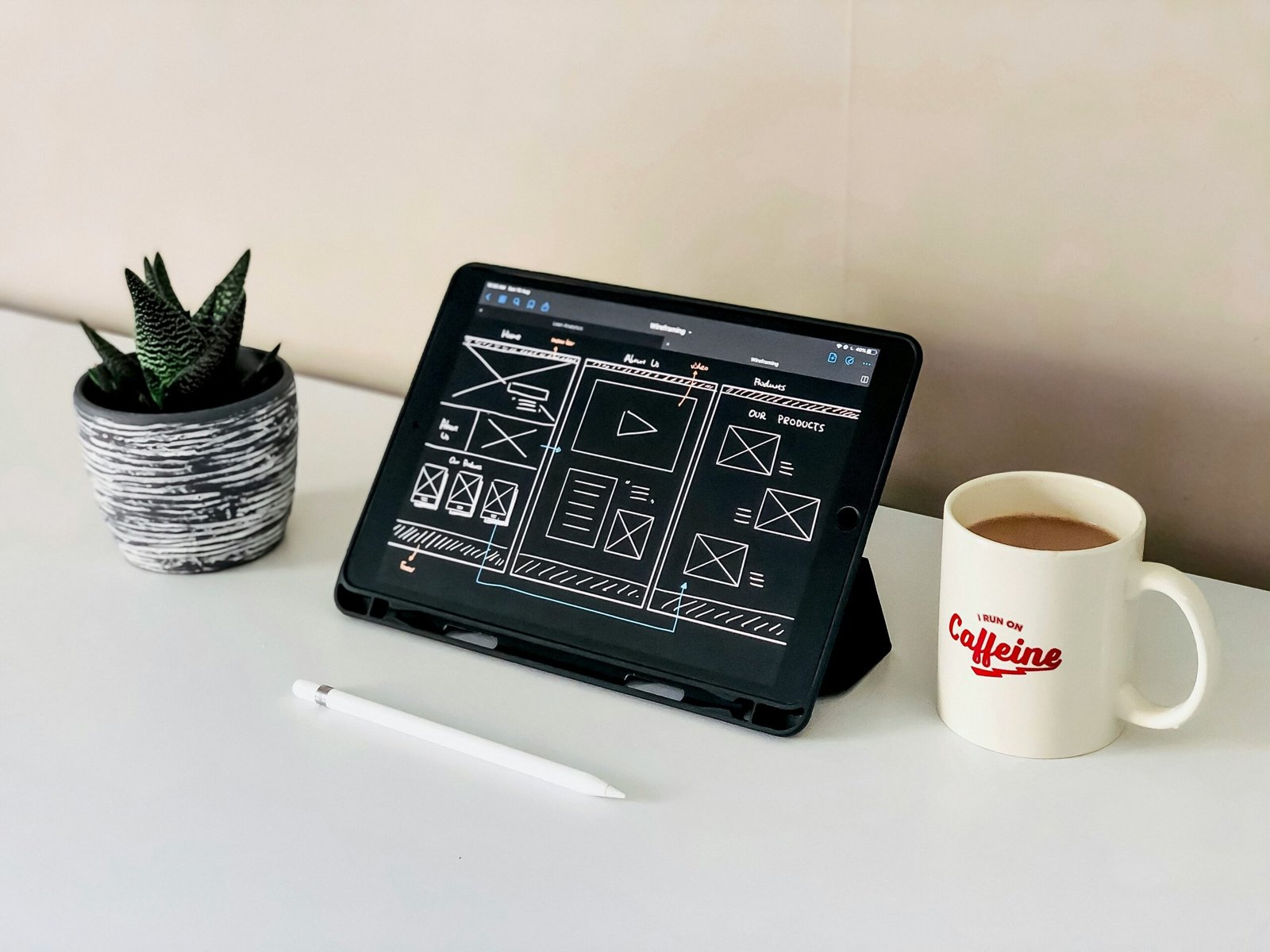
by James Dean | May 10, 2024 | Blogs, Web Design
Introduction
Designing a website is a complex process that requires careful planning and execution. Whether you are creating a personal blog or a business website, there are several key steps that you need to follow to ensure a successful design. In this article, we will explore the seven major steps to designing a website, from defining your goals to launching the final product.
Step 1: Define Your Goals
The first step in designing a website is to clearly define your goals. Consider what you want to achieve with your website and how it will align with your overall business or personal objectives. Are you looking to sell products, provide information, or showcase your portfolio? By understanding your goals, you can create a design that is tailored to meet your specific needs.
Step 2: Conduct Research
Once you have defined your goals, it’s time to conduct research. Look at other websites in your industry or niche to get inspiration and ideas. Analyze their design, layout, and functionality to understand what works well and what can be improved. Additionally, research your target audience to gain insights into their preferences and expectations. This research will help you make informed decisions during the design process.
Step 3: Plan Your Content
Content is a crucial component of any website. Before diving into the design, take the time to plan your content strategy. Determine what pages and sections your website will include and how they will be organized. Consider the type of content you will need, such as text, images, videos, or interactive elements. Planning your content in advance will ensure a smooth and cohesive design process.
Step 4: Create a Wireframe
A wireframe is a visual representation of your website’s structure and layout. It serves as a blueprint for the design process. Create a wireframe that outlines the placement of elements, such as the header, navigation menu, content sections, and footer. This step allows you to focus on the overall structure of the website before adding visual elements. There are several tools available online that can help you create wireframes easily.
Step 5: Choose a Design and Layout
Now comes the fun part – choosing a design and layout for your website. Consider your brand identity and target audience when selecting colors, fonts, and imagery. Ensure that the design reflects the overall tone and personality of your website. Keep in mind that the layout should be user-friendly and intuitive, making it easy for visitors to navigate and find the information they need.
Step 6: Develop and Test
Once you have finalized the design and layout, it’s time to develop your website. This step involves writing code, creating templates, and integrating any necessary functionalities. If you are not familiar with web development, you may consider hiring a professional or using a website builder. After development, thoroughly test your website to ensure that it functions properly on different devices and browsers. Pay attention to loading speed, responsiveness, and overall user experience.
Step 7: Launch and Maintain
The final step in designing a website is to launch it and make it available to the public. Before launching, double-check all the elements and ensure that everything is in order. Once your website is live, regularly monitor its performance and make any necessary updates or improvements. Keep your content fresh and up-to-date to engage your audience and maintain a professional online presence.
Conclusion
Designing a website involves several major steps, from defining your goals to launching the final product. By following these steps and investing time and effort into the design process, you can create a website that effectively communicates your message and achieves your objectives. Remember to continuously evaluate and update your website to keep up with changing trends and user expectations. With a well-designed website, you can make a lasting impression on your visitors and establish a strong online presence.

by James Dean | May 10, 2024 | Blogs, Web Design
Understanding the Cost of Website Design
So, you’ve decided to take your business online and create a website. Congratulations! It’s a crucial step in today’s digital age. However, you may find yourself wondering, “How much should I pay to design a website?” Well, my friend, you’ve come to the right place.
The Factors that Influence Website Design Costs
Before we dive into the specifics of website design costs, it’s essential to understand the factors that influence them. Just like any other service, the cost of website design can vary based on several key factors:
1. Complexity of the Website
The complexity of your website is one of the primary factors that determine the cost. A simple, one-page website will naturally cost less than a large e-commerce website with multiple pages and advanced functionality.
Think about the features you want your website to have. Will it require a content management system (CMS) for easy updates? Will it need e-commerce functionality to sell products? The more complex your website, the more time and expertise it will require, thus affecting the cost.
2. Customization and Design
The level of customization and design you desire for your website will also impact the cost. If you’re looking for a unique, eye-catching design tailored specifically to your brand, it will require more time and effort from the designer.
On the other hand, if you’re willing to use pre-designed templates or themes, it can significantly reduce the cost. These templates are often customizable to some extent, allowing you to maintain a professional look without breaking the bank.
3. Content Creation
Content is king, and your website needs compelling and engaging content to attract and retain visitors. Creating high-quality content takes time and expertise, and you may need to hire a professional copywriter or content creator to ensure your website’s success.
If you already have content ready, it can save you some money. However, if you need assistance with content creation, it’s essential to factor in the additional cost.
4. Responsive Design
In today’s mobile-driven world, having a responsive website is non-negotiable. A responsive design ensures that your website looks and functions seamlessly across various devices, including smartphones, tablets, and desktops.
Developing a responsive website requires additional coding and testing to ensure optimal user experience. This extra effort may increase the overall cost of website design.
5. Additional Features and Functionality
Do you need any additional features or functionality on your website? This could include integration with third-party tools, social media feeds, contact forms, live chat support, or any other specific requirements you may have.
Each additional feature will require time and expertise to implement, which can impact the overall cost. It’s essential to clearly communicate your requirements to the designer to get an accurate estimate.
Understanding the Pricing Models
Now that you’re familiar with the factors influencing website design costs, let’s talk about the different pricing models you might encounter:
1. Fixed Price
Some web designers offer fixed pricing for their services. This means they provide a set price for a specific package or type of website. Fixed pricing can be beneficial if you have a clear idea of what you want and don’t anticipate any major changes or additions during the design process.
However, keep in mind that if you do require any changes or additional features, it may incur additional costs. Make sure to clarify the terms and conditions with the designer before finalizing the project.
2. Hourly Rate
Many web designers charge an hourly rate for their services. This pricing model allows for more flexibility, as you pay for the actual time and effort invested in designing your website.
Hourly rates can vary depending on the designer’s experience, location, and the complexity of the project. It’s important to have a clear understanding of the estimated number of hours required for your website design to avoid any surprises.
3. Package Pricing
Some web design agencies offer package pricing, where they provide different tiers of services at fixed prices. These packages often include a set number of pages, features, and design options.
Package pricing can be a convenient option if you’re looking for a specific set of features within a defined budget. However, make sure to assess whether the package meets your requirements and if any additional costs may be involved for customization or additional features.
Getting Quotes and Comparing Costs
Now that you have a good understanding of the factors influencing website design costs and the different pricing models, it’s time to get quotes from multiple designers or agencies.
When requesting quotes, provide detailed information about your requirements, including the complexity of the website, desired features, customization needs, and any additional functionality you may require. The more specific you are, the more accurate the quotes will be.
Once you receive the quotes, take the time to compare them based on the factors mentioned earlier. Don’t just focus on the price; consider the designer’s experience, portfolio, and client reviews as well.
Remember, investing in a well-designed website is an investment in your business’s online presence and success. Don’t solely base your decision on cost; prioritize quality and expertise to ensure you get a website that truly represents your brand and meets your goals.
Conclusion
So, how much should you pay to design a website? Well, as you’ve probably gathered by now, it depends on various factors such as complexity, customization, content creation, responsive design, and additional features.
Take the time to evaluate your specific needs and budget, and don’t hesitate to reach out to multiple designers or agencies for quotes. Remember, a well-designed website is an investment that can yield significant returns for your business.
Good luck with your website design journey, and may your online presence shine bright!
Recent Comments